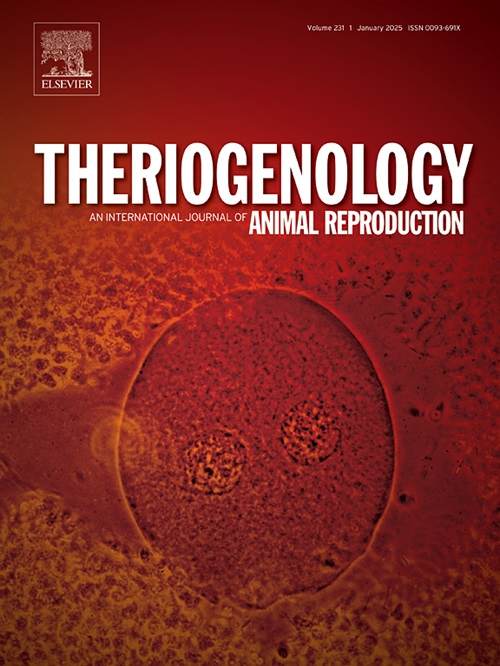Regulation of PPARγ in the development of early sheep embryos in vitro
IF 2.4
2区 农林科学
Q3 REPRODUCTIVE BIOLOGY
引用次数: 0
Abstract
Lipid metabolism plays an important role in the regulation of early embryonic development in mammals. However, the effect of lipid metabolism mediated by peroxisome proliferator-activated receptor γ (PPARγ) on the early embryonic development of sheep remains unclear. In this study, rosiglitazone (RSG), a PPARγ activator, was added to the in vitro embryo culture (IVC) medium to regulate the continuous expression of PPARγ. This study aimed to evaluate PPARγ expression during early embryonic development in sheep as well as its effects on lipid deposition, reactive oxygen species (ROS) and glutathione (GSH) levels, apoptosis and lipid metabolism-related gene expression, and embryonic development. PPARγ was not detected at 2-cell, 4-cell, 8-cell, and morula stage, while widely expressed with obvious nuclear expression features in blastocysts. Notably, treatment with 5 μM RSG in sheep parthenogenetic activated (PA) embryos significantly increased the blastocyst rate, lipid content, and GSH levels, while decreasing ROS levels. Further analysis revealed that RSG treatment upregulated the expression levels of antioxidant genes (SOD2 and CAT), anti-apoptotic gene (BCL2), and lipid metabolism-related genes (SCD-1, CD36, PLIN2, FABP3, and FABP4). Taken together, these results suggest that PPARγ plays a vital role in promoting embryonic development by enhancing lipid metabolism and reducing oxidative stress.
PPARγ在绵羊早期胚胎体外发育中的调控作用。
脂质代谢在哺乳动物早期胚胎发育调控中起重要作用。然而,过氧化物酶体增殖物激活受体γ (PPARγ)介导的脂质代谢对绵羊早期胚胎发育的影响尚不清楚。本研究将PPARγ激活剂罗格列酮(RSG)添加到体外胚胎培养(IVC)培养基中,调节PPARγ的连续表达。本研究旨在探讨PPARγ在绵羊胚胎早期发育过程中的表达及其对脂肪沉积、活性氧(ROS)和谷胱甘肽(GSH)水平、细胞凋亡和脂质代谢相关基因表达及胚胎发育的影响。PPARγ在2细胞、4细胞、8细胞和桑葚胚期均未检测到,但在囊胚中广泛表达,具有明显的核表达特征。值得注意的是,5 μM RSG处理绵羊孤雌生殖激活(PA)胚胎可显著提高囊胚率、脂质含量和GSH水平,同时降低ROS水平。进一步分析发现,RSG处理上调了抗氧化基因(SOD2和CAT)、抗凋亡基因(BCL2)和脂质代谢相关基因(SCD-1、CD36、PLIN2、FABP3和FABP4)的表达水平。综上所述,这些结果表明PPARγ通过增强脂质代谢和减少氧化应激在促进胚胎发育中起重要作用。
本文章由计算机程序翻译,如有差异,请以英文原文为准。
求助全文
约1分钟内获得全文
求助全文
来源期刊

Theriogenology
农林科学-生殖生物学
CiteScore
5.50
自引率
14.30%
发文量
387
审稿时长
72 days
期刊介绍:
Theriogenology provides an international forum for researchers, clinicians, and industry professionals in animal reproductive biology. This acclaimed journal publishes articles on a wide range of topics in reproductive and developmental biology, of domestic mammal, avian, and aquatic species as well as wild species which are the object of veterinary care in research or conservation programs.
 求助内容:
求助内容: 应助结果提醒方式:
应助结果提醒方式:


